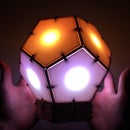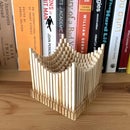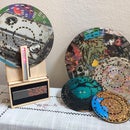Introduction: Low-cost Fluorescence and Brightfield Microscopes
Fluorescence microscopy is an imaging modality used to visualize specific structures in biological and other physical samples. The objects of interest in the sample (e.g. neurons, blood vessels, mitochondria, etc.) are visualized because fluorescent compounds attach to only those specific structures. Some of the most beautiful microscopy images are collected with fluorescence microscopes; check out these images presented on the Nikon MicroscopyU webpage to see some examples. Fluorescence microscopy is useful for many biology studies that focus on a specific structure or cell type. For instance, many research studies on neurons in the brain depend on the use of fluorescence microscopy modalities that specifically image neurons.
In this instructable, I will go over the basic principles of fluorescence microscopy and how to build three different low-cost fluorescence microscopes. These systems usually cost thousands of dollars, but there have been recent efforts to make them more readily available. The designs I present here utilize a smart phone, a dSLR, and a USB microscope. All of these designs also work as brightfield microscopes. Let's get started!
Step 1: Fluorescence Microscopy Overview
To understand the basic idea of fluorescence microscopy, imagine a thick forest at night filled with trees, animals, bushes, and everything else living in a forest. If you shine a flashlight into the forest you see all of these structures and it can be hard to visualize a specific animal or plant. Let's say you were only interested in seeing blueberry bushes in the forest. To accomplish this, you train fireflies to be attracted to only blueberry bushes, so that only blueberry bushes light up when you look into the forest. You could say that you labeled the blueberry bushes with the fireflies so you could visualize only the blueberry structures in the forest.
In this analogue, the forest represents the entire sample, the blueberry bushes represent the structure you want to visualize (e.g. a specific cell or subcellular organelle), and the fireflies are the fluorescent compound. The case in which you shine the flashlight alone without the fireflies is analogous to bright-field microscopy.
The next step is understanding the basic function of fluorescent compounds (also called fluorophores). Fluorophores are really small objects (on the scale of nanometers) engineered to attach to specific structures in the sample. They absorb light over a narrow range of wavelengths and re-emit another wavelength of light. For example, one fluorophore may absorb blue light (i.e. the fluorophore is excited by blue light) and then re-emit green light. Usually this is summarized by an excitation and emission spectrum (picture above). These graphs show the wavelength of light that the fluorophore absorbs and the wavelength of light that the fluorophore emits.
The microscope design is very similar to a normal brightfield microscope with two major differences. First, the light to illuminate the sample must be the wavelength that excites the fluorophore (for the example above, the light was blue). Second, the microscope needs to collect only the emission light (the green light), while blocking the blue. This is because the blue light goes everywhere but the green light comes only from the specific structures in the sample. To block the blue light, the microscope usually has something called a longpass filter that lets green light go through without blue light. Each longpass filter has a cutoff wavelength. If the light has a longer wavelength than the cutoff, then it can pass through the filter. Hence the name, "longpass." Shorter wavelengths are blocked.
Here are several overviews of fluorescence microscopy:
https://bitesizebio.com/33529/fluorescence-microsc...
Step 2: Modeling Microscopes With Ray Optics
This is an extra step about the underlying principles to design microscopes. It is not necessary for building a fluorescence microscope, so you can skip it if you don't want to dive too deeply into optics.
Bright-field and fluorescence microscopes can both be modeled using ray optics. The basic premise of ray optics is that light behaves like rays that propagate away from a light source. When you look around the room, you see light coming from the sun out your window or maybe from a light bulb. The light then is either absorbed by the objects in the room or reflected. Some of that reflected light makes it towards your eyes. If an object is illuminated, you can imagine each point on the object emitting rays of light in all directions (picture above). Lenses, like the ones in our eyes, focus the rays back down to a point so we can see the object. Without the lens, the rays continue to propagate outward and do not form an image.
So how do we make optical systems that magnify small objects? In order to understand the design, you really only need to know two equations: the thin lens imaging and magnification equations:
1/f = 1/si + 1/so
M = -si/so
f is the focal length of a lens. A shorter focal length means the lens has more focusing power.
so is the object distance; the distance between the lens and the object (e.g. a tree).
si is the the image distance; the distance between the lens and where an image is formed
M is the magnification; how big the image is relative to the object. For microscopes, we want to increase the magnification.
For a full tutorial on the thin lens equation, check out this Khan Academia video. In the gif above, you can see how moving the object closer to the lens increases the image distance and therefore the magnification. The vertical line with two arrows represents a lens.
Macro-photography - dSLR design 1
From these equations, we can see that if we use a single lens, then the way to magnify the image is to increase the image distance. This is accomplished with a camera by moving the lens farther away from the sensor (see pictures above). Many DIY macro-photography is accomplished by simply moving the lens out using tube extenders. It is a great trick that provides a cheap alternative to expensive macrolenses. To increase the magnification, you can also decrease the focal length of the lens. The reason the lens is flipped is a little more complicated and requires an understanding of the principal planes of optical systems. Let me know if you are looking for an explanation!
USB microscope
USB microscopes work in the same way. They are specifically designed so they can image objects very close to the lens. The closer the object to the lens, the greater the magnification. They also have several lens elements that move around to allow you to focus at different distances, similar to a zoom lens. Besides the lens system used, they are very similar to webcams.
Smart phone design
For a smartphone, the image distance is fixed (i.e. you can't move the lens). So how can we convert it into a microscope? If you rearrange the equations above, you realize the magnification can be increased by making the focal length of the lens shorter: M = si/f -1. It is not the best idea to open up your phone to change the lens of the camera, so you can instead add a biconvex lens right outside the phone. By adding another lens, you decrease the effective focal length of the lens system. I have seen people use disposable camera lenses and lenses from laser pointers. Above is a ray diagram roughly showing how the light bends through these different systems.
Infinity-corrected microscope - dSLR design 2
The final design I go over in this instructable is most similar to the design of a microscope you'd find in a laboratory. There are two lens systems in the design: an objective lens and a tube lens. The objective lens is the component closest to the sample. The sample is placed right at the focal plane so that the light out of the objective actually does not form an image (i.e. si = infinity). The image is formed by the tube lens onto a sensor. The magnification of this system is given by the ratio of the objective lens and tube lens focal lengths. Here is a video for more information on brightfield microscopes that have this design.
Step 3: Supply List
All designs
Supplies
Excitation LEDs: WS2801/WS2811 or high power blue LED
Longpass filter: Thorlabs, Edmund optics, Ealing, expensive option: Semrock
Helping hands for holding filters: https://www.amazon.com/ProsKit-900-015-Helping-Han...
Prepared microscope slides: https://www.amscope.com/25-microscope-prepared-sli...
Arduino Nano
Push button
1kOhm resistor
4X M3x12 bolts
4X M3 nuts
Tough plastic or cover slips
Fluorescent dye (e.g. highlighter ink, fluorescein, or this?)
Tools:
3D printer for adapters
Power drill
Hot glue gun
Plastic pipette
Scissors
Allen wrench
Soldering iron for LED strip
1. Smart phone design
Smart phone; I used my iPhone 5s
Disposable camera lens, laser pointer lens, or Blips lens
Smart phone holder
2. USB camera design
USB microscope: https://www.amazon.com/Plugable-Microscope-Flexibl...
6mm diameter magnets
3. dSLR design
dSLR; I used my Nikon D5000
Tube lens; 180mm achromatic doublet: https://www.thorlabs.com/thorproduct.cfm?partnumbe...
Infinity corrected objective lens: https://www.amscope.com/10x-infinity-plan-achromat...
2inch diameter lens tubes: https://www.thorlabs.com/thorproduct.cfm?partnumbe...
F-mount to SM2 adapter: https://www.thorlabs.com/newgrouppage9.cfm?objectg...
Retaining rings
Step 4: Building a Light Supply
A key difference in a fluorescence microscope is the light supply. Instead of white light (i.e. many wavelengths) that is used in brightfield microscopes, fluorescence microscopes require light of a specific color (i.e. a narrow range of wavelengths). For example, blue light has a wavelength around 488nm.
I decided to build the fluorescence microscope with an addressable LED strip so that it was easy to switch between fluorescence and brightfield imaging. The mount was designed for all three microscope designs I show in this instructable. I designed it in Fusion360 and then 3D printed three parts for it. The mount angles the LEDs inward to maximize the light incident on the sample. In the gif, you can see how it integrates with the USB microscope. For the other microscopes, it just holds the LEDs.
First add one M3 nut into the slot of the black LED holder and slide in an M3x12 bolt. The bolt and nut act as a setscrew to secure the USB microscope into place. Next cut eight LEDs from an W2801 or WS2811 LED strip and push the LEDs into the holes. Connect the red cable to 5V, the blue cable to Gnd, and the white cable (data) to pin D2. For the microscope I wanted to cycle through several colors, so I added a push button connected to pin D3. Attached is code for running the light supply.
Next add four M3 nuts to the slits in the gray LED base and rest the LED assembly on top. Add the cover piece, slide in the M3 bolts, and tighten them with an allen wrench. The entire assembly can then be mounted onto the black base with the circular bottom.
Step 5: Preparing Fluorescent Samples
Maybe the toughest part of fluorescence microscopy is making labeled samples. The challenge is getting the fluorophores to only specific structures, which is a complex chemical process. You can order fluorescence slides, like these mouse kidney slides, but they are expensive. Calibration slides are also available and would be useful for validating your fluorescence microscope.
To make low-cost fluorescent slides on your own, you will need a fluorescent solution (e.g. highlighter fluid, fluorescein, etc.), hard plastic (or coverslips), scotch tape, a plastic pipette, and a material that absorbs the solution. Add a couple drops of the fluorescent solution to the structures you want to glow in your image. In my example, I am labeling some yarn. Place the object on a paper towel to absorb the excel fluid. Remember you don't want the fluorescent fluid getting on anything else in the sample!
Once you are sure the labeled object is dry, add it to the rest of the sample on the cover slip. I included a piece of tissue paper with no fluorescent fluid. Instead of a cover slip, you can use a piece of hard plastic cut to the dimensions of a cover slip. Use tape to attached the sample to the coverslip. You are now ready to image your fluorescent sample! Note that the fluorescent solution may dry out and not work as well over time.
Another idea I had to make a fluorescent sample was to put a flower in a fluorescent solution. The fluorescent solution would travel through the veins of the plant and label them. Here is more information on fluorescent flowers.
Step 6: Smart Phone Fluorescence Microscope
Take the lens out of the disposable camera and use the 3D printer mount to slide the lens over the smartphone. If you don't have a 3D printer, you can just tape the edges of the lens onto your phone. There are even nicer lenses specifically designed for smartphone microscopes that you can also purchase from Smart Micro Optics.
With this simple setup, you already have an awesome digital brightfield microscope in your hand. Here are a few more resources on building these types of microscopes. Above you can see a few examples of pictures I took using the disposable camera lens and iPhone5s. If you want an explanation for why this works, check out Step 3.
Now onto the fluorescence microscope. Mount the smartphone in a tripod mount and place the light supply behind the smart phone. Place the fluorescent sample between the smartphone and light supply. Finally, use the helping hands to move the filter between the sample and smartphone. The filter will block out the blue excitation light.
The brightfield results with this microscope were really impressive, but I was disappointed by the fluorescence imaging. The major problem is the iPhone's automatic color and exposure correction. Without control of these features, the entire frame turns blueish green and the fluorescently labeled string does not pop out. There is probably a fix for this, because I found this smartphone fluorescence microscope by Qingshan Wei and Aydogan Ozcan.
Step 7: USB Fluorescence Microscope
First, you need to 3D print the filter holder. The STL file is below. Glue magnets all facing in the same direction to the filter holder. Then glue magnets in the opposite direction to the mount holding the LEDs. When both these assemblies are placed in the LED base, they lock the filter into place. Slide the USB microscope into the LED mount and tighten the set screw. You can also add painter's tape around the USB microscope to ensure a tight fit.
To switch between brightfield and fluorescence microscope, slide the filter mount. The longpass filter will be in front of the USB microscope for fluorescence imaging. Then turn the LED strip on so that the right excitation light is on (probably blue light). Now slide in your fluorescent sample and save some images. I used the program Digital Viewer on my Mac to use the USB microscope. Above are some examples. I was really impressed with the results!
Attachments
Step 8: DSLR Microscope
The final design gives the highest magnification and best quality, but it is the most expensive. Add the Fmount-to-SM2 adapter to the dSLR, and then screw in a 2" and 3" tube extender. The 180mm achromatic doublet lens is then mounted. Drill a hole in the cap for the objective lens so that light can pass through and then push it into the custom objective lens to SM2 adapter (the STL file is above). Add a 3", 2", and 1.5" tube extender after the tube lens, followed by the objective lens.
Next you need to place the camera securely on a table followed by the longpass filter, sample, and the light supply. I used my dSLR mount from my CT scanner project (see Step 5 of that instructable), but you can also use a tripod. The filter can be held in place using the helping hands. Move the filter away for brightfield imaging. The first two example images above are the same sample, one in brightfield mode and the other in fluorescence mode. Notice the major difference in the structures! I think this is the best example of how useful fluorescence microscopy is. If the sample is well labeled, you can visualize specific structures and blackout everything else.
Another trick for processing the images is to simply turn up the contrast. You can see that in the two images above containing brightfield and fluorescence images.
Attachments
Step 9: Microscope Comparison
Above are a few side-by-side comparisons of the fluorescence and bright-field imaging results. The dSLR design has the best resolution, contrast, and overall image quality, but is the most expensive. I think the USB microscope is the best overall deal for getting a fluorescence microscope up and running. The only major cost is the longpass filter, which is around $60. I am still looking for cheaper alternatives to lower the overall cost of the microscopes. I was a little disappointed with the iPhone results, but this design may be improved if I can adjust the exposure and color correction manually (any ideas?).
The focus knob on the USB microscope also makes imaging a lot easier in comparison to the dSLR, which requires finely moving the sample. There are high precision linear stages available, but the ones I have been able to find are at least $100. I made a prototype for a cheap linear stage using calipers, but don't have that shown in this instructable. MyPhotonics came up with some brilliant translation stage designs made out of LEGOs. I haven't tried them, but they look like another great low-cost solution.

Runner Up in the
Optics Contest




















